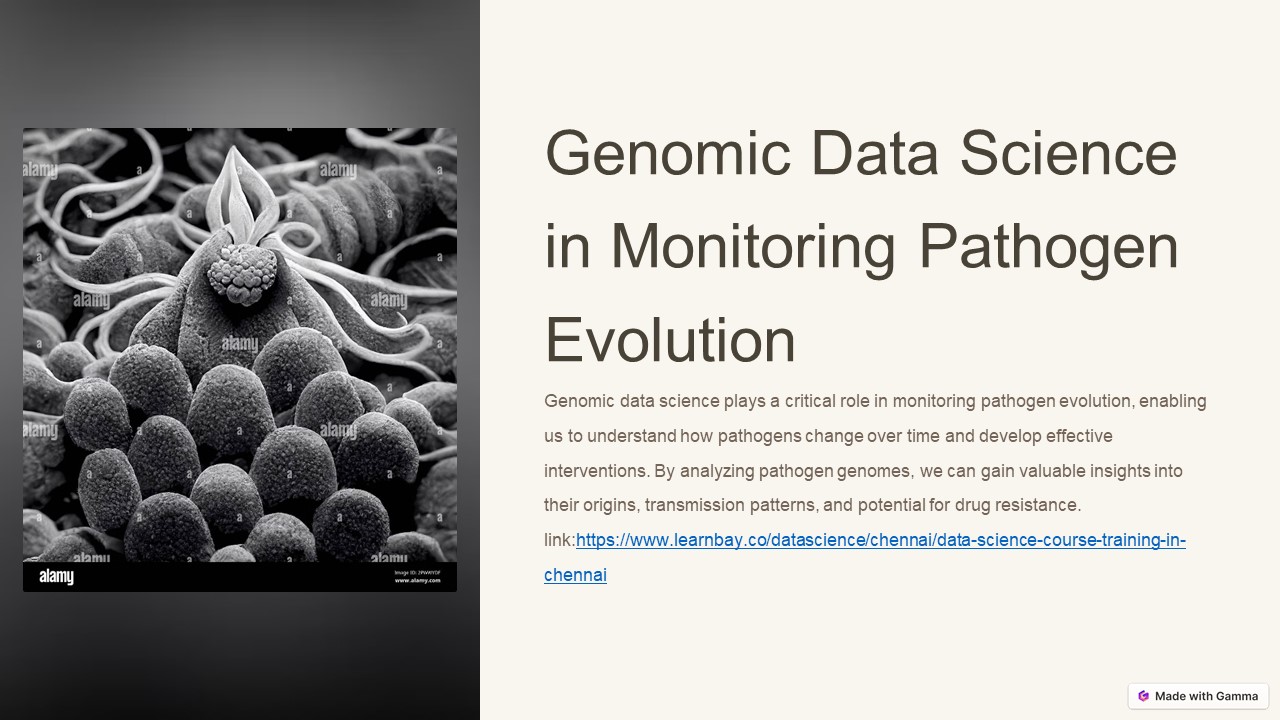Genomic Data Science in Monitoring Pathogen Evolution - PowerPoint PPT Presentation
Title:
Genomic Data Science in Monitoring Pathogen Evolution
Description:
Genomic Data Science in Monitoring Pathogen Evolution involves using advanced genomic sequencing and data analysis techniques to track and understand how pathogens like viruses and bacteria evolve over time. By analyzing genetic changes, scientists can identify new variants, monitor transmission patterns, predict outbreaks, and guide the development of vaccines and treatments, enhancing public health responses to emerging infectious diseases. – PowerPoint PPT presentation
Number of Views:2
Title: Genomic Data Science in Monitoring Pathogen Evolution
1
Genomic Data Science in Monitoring Pathogen
Evolution
Genomic data science plays a critical role in
monitoring pathogen evolution, enabling us to
understand how pathogens change over time and
develop effective interventions. By analyzing
pathogen genomes, we can gain valuable insights
into their origins, transmission patterns, and
potential for drug resistance. linkhttps//www.le
arnbay.co/datascience/chennai/data-science-course-
training-in-chennai
2
Importance of Monitoring Pathogen Evolution
Drug Resistance
Disease Spread
1
2
Pathogen evolution can lead to drug resistance,
rendering existing treatments ineffective.
Understanding pathogen evolution helps us track
and predict disease outbreaks, allowing for
timely interventions.
Vaccine Development
Public Health Strategies
3
4
Knowledge of pathogen evolution informs the
development of effective vaccines and diagnostics.
Genomic data helps us tailor public health
strategies to combat evolving pathogens.
3
Data Sources for Pathogen Genomic Surveillance
Clinical Samples
Environmental Samples
Public Databases
Genetic information from clinical isolates, such
as bacteria or viruses, provides insights into
current pathogen populations.
Genomic data from environmental sources, like
wastewater or soil, can reveal the presence of
pathogens and their potential for spread.
Genomic databases like NCBI and GenBank serve as
repositories for pathogen genome sequences,
providing a vast resource for research.
4
Bioinformatics Techniques for Pathogen Genome
Analysis
1
2
3
4
Genome Sequencing
Genome Assembly
Genome Annotation
Comparative Genomics
Next-generation sequencing technologies allow for
rapid and accurate sequencing of pathogen genomes.
Assembling the sequenced fragments into a
complete genome allows for analysis of the
pathogen's genetic makeup.
Annotating the genome identifies genes, proteins,
and other functional elements, providing insights
into pathogen characteristics.
Comparing genomes of different pathogen strains
reveals genetic variations and evolutionary
relationships.
5
Identifying Genetic Markers of Pathogen Evolution
SNPs (Single Nucleotide Polymorphisms)
Single nucleotide variations in the genome that
can indicate genetic changes.
Indels (Insertions and Deletions)
Variations in the genome that involve insertions
or deletions of DNA segments.
Structural Variations
Larger-scale changes in the genome, such as
inversions, translocations, or duplications.
6
Predictive Modeling of Pathogen Spread and
Emergence
Epidemiological Data
Integrate genomic data with epidemiological data
to understand disease transmission patterns.
Phylogeny
Construct phylogenetic trees to trace the
evolutionary history of pathogens and identify
transmission routes.
Modeling
Use mathematical models to predict pathogen
spread and emergence based on genomic and
epidemiological data.
7
Integrating Genomic Data with Epidemiological
Surveillance
Real-Time Monitoring
Targeted Interventions
Integrate genomic data with real-time
surveillance systems to track pathogen evolution
and emergence.
Use genomic data to identify high-risk
populations and areas for targeted interventions.
Public Health Communication
Communicate genomic insights to the public to
raise awareness and promote preventive measures.
8
Challenges and Future Directions in Genomic Data
Science for Pathogen Monitoring
Data Management
Collaboration
Developing robust systems for storing, managing,
and sharing massive genomic datasets is crucial.
Enhancing collaboration among researchers,
clinicians, and public health officials is
essential for effective pathogen monitoring.
Technological Advancement
Ethical Considerations
Continued development of advanced sequencing
technologies and bioinformatics tools is needed.
Addressing ethical concerns related to data
privacy, access, and potential misuse is
important.































